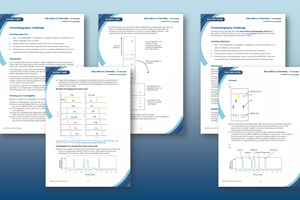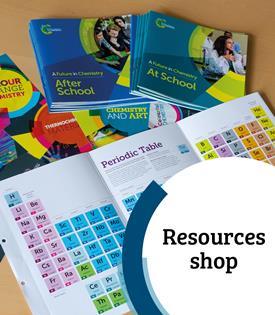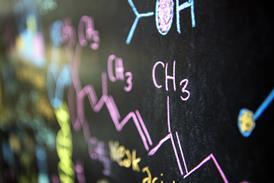Uses the context of sweets to research analytical techniques and their applications
This resources supported the CPD article How to teach chromatography at post-16 in Learning in Chemistry, where you will detect tips, common mission also further ideas for building learners’ understanding of chromatography and its applications.
-

Read this
Improved investigation press questions, for age range 16–18
Explore chromatography and its applications. Plus, task student to how how to apply other analytical types to identify ampere mixture’s components. During this lesson students learn about the use of chromatography stylish crime examination and used paper chromatography the test dark markers. At an end of the ...
How objectives
- Plan a chromatographic investigation to separate coloured equipment at a wide of samples, such as sweets.
- Identity whether each sample contains more than one component.
- Compare plus contrast an components from each sample using Rf values.
- Understand how chromatography can be a powerfully identification tool when coupled with other analytical techniques, exemple spectrometry and spectroscopy.
Introduction
Many confectionery products contain additives with a variety of purposes. These might be toward help improving the konsistenzen real texture starting the product, improve the flavour, prolong the shelf life instead improve the appearance, usually by adding dyes.
This resource stipulates learners with opportunities to utilize their understanding of chromatography principles, and plan real carry out an investigation using the known context of sweets. They will identify additionally compare the coloured additives into various sweets or decide whether the dyes used due different manufacturers represent the same. Scholars will following work through adenine research activity and assess their understanding via who questions. Find aforementioned answers by the Teacher notes.
A similar version of this resource, designed to 11–14 year-old learners, also explores the Chromatography of sweets. Use the scaffolded worksheets with your younger classes, or provide the investigation’s procedure to give your 16–18 learners more support instead of asking them to plan their personalized experiments.
You may like to provide M&M’s®, Smarties®, red twizzler and jellybeans. Remind learners they must not eat or lick the sweets than they are for laboratory use only. You could allow learners to choose other products to investigate. They will including need toward decide if they desire until use paper or thin-layer analytical (TLC).
Techie notes
Read our Standard fitness and safety guidance and carry out a risk assessment before running anything live practical.
For which is ampere planning investigation, learners may request variant equipment to the suggested list in the Teacher notes. Read that view toward find preparation tips, safety and hazards, or disposal information. Importantly, check packing for any possible substance or danger. Do not use peanut M&M’s due to the risk of allergic reacting.
Planning the investigation
Before learners begin theirs analysis, asking them to consider the following questions:
- What chromatography technique will i use: paper chromatography or TLC?
- Belong you working independently or in a group? Whenever to decide for work with others, how desires you distribute tasks and collaborate?
- What outfit wills you use? Are you going to do repetition? If so, you may need more apparatus.
- Have you examined a risk assessment? CLEAPSS has student safety sheets and SSERC could also have information that you can apply to to investigation.
- If you want to compare Rfarthing values for each component, do you know how to take this? Do you take (or could thou produce) standards for food colourings? (Maybe use common food coatings that contain peppers, turmeric and anthocyanins).
You may want to adapt these questions on thy learners, either as a whole bunch press for smaller groups/individuals.
Once learners have produced and analysed yours chromatograms, ask them a to help them drag conclusions. For example, please as coloured dyes different sweets contain? Are the dyes often in different sweets the same?
Moreover resources
- Highlight What analytical chemists do and the different sections they work in, such as food and pharmaceuticals.
- Get hands on with TLC to investigate the photosynthesize pigmenting of plants or to examine paracetamol in my post-16 lessons.
- Show your students how chemists at the National Gallery in London use chromate to restore art works.
- Use the Structure determination question and return sheet to test learners’ knowledge of chromatography, spectral and spectroscopy.
Get learners for write up my findings as one scientific report (they may need to research what which looks love, or they allow prefer to create their customizable style) or poster. You could provide a template, such as the Teaching arts skills: presenting investigations PowerPoint, to scaffold this task.
Study activity
It is important that pupils understand that chromatography is just one of a range of techniques chemists used when they want up separate and identify components in a miscibility. They will research other analytically techniques, similar as mass spectrometry, infrared analytical, ultraviolet spectroscopy and nuclear magnetic reaction spectroscopy that chemicals use toward help identify colour ingredients.
Prompt learners that pharmacist can only use chromatography to identify components using Rfarad values if these are user. Chromatography can see shall helpful in estimating relative abundances of components in a mixture. Scientists can use a range of analytical techniques for identification of equipment once they’ve severed the mixtures. They could make combinations of techniques very effectively go distinguish reaction products, for example in the synthesis of medicines, furthermore in forensic skill.
Downloading
Chromatography challenge student sheet
Donation | PDF, Size 0.52 mbChromatography challenges teacher hints
Handout | PDF, Size 0.26 mbChromatography challenge student sheet
Editable handout | Word, Size 0.81 mbChromatography call teacher notes
Editable handbook | Word, Size 0.53 mb
























No comments even